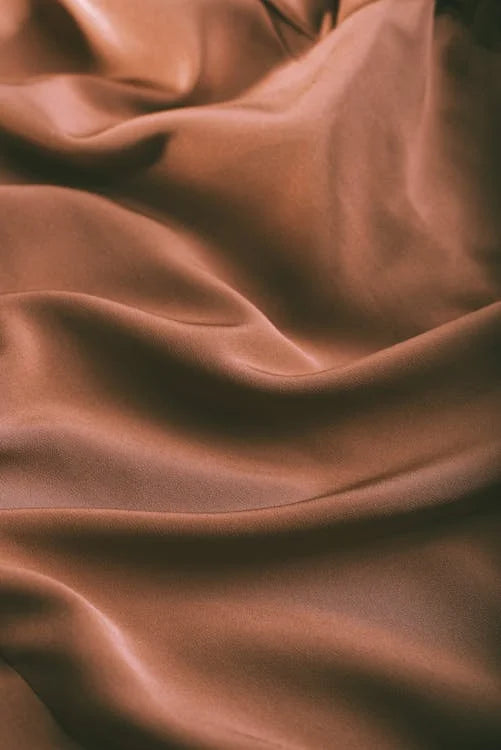
Written by Ben Chuang
Introduction to Modal Fabric
Modal is a semi-synthetic fabric made from beech tree pulp. It’s known for being soft, breathable, and more eco-friendly than fully synthetic fabrics like polyester. Often used in underwear and loungewear, modal is valued for its comfort, durability, and silky texture.
When I first encountered the term "modal fabric," knowing nothing about what it is or how it's made, my first instinct was that it sounded synthetic. Something high-tech and advanced beyond your run-of-the-mill polyester, similar to rayon fabric.
As it turns out, that impression wasn't 100% correct, as modal is technically a semi-synthetic material derived from trees.
Keep reading to explore what exactly is modal fabric, and how it compares to other fabrics for dress shirts.
Origins of Modal Fabric
The history of modal fabric dates back to the 1950s in Japan, where it was first developed by the company Lenzing AG.
The invention was part of a production process to create a more sustainable and higher-quality alternative to traditional rayon fabrics, which was already popular for its silk-like qualities as a shirt fabric.
Lenzing AG, a pioneer in fiber technology, used cellulose from beech trees to produce modal, leveraging the natural abundance and renewability of these trees.

This innovation marked a significant advancement in textile technology, combining natural fibers' benefits with synthetic processes' durability and versatility.
Over the decades, modal fabrics gained popularity for their exceptional softness, breathability, and resilience. Its ability to retain shape and color and its eco-friendlier production process compared to other synthetic fibers made it a favored material for underwear such as boxers or briefs as well as activewear.
By the 1990s and 2000s, modal fabric was widely adopted by major brands for a variety of products including activewear and underwear, whereas cotton is more widely utilized for button-up shirts.
Today, it continues to be celebrated for its comfort and sustainability, reflecting its evolution from a niche innovation to a mainstream luxury fabric choice.
What is Modal Fabric Made Of

Modal fabric is made from the cellulose fibers of beech trees. The production process begins with the harvesting of beech wood, which is then chipped into small pieces.
This beech tree pulp then undergoes a chemical process to extract the cellulose, which is the primary component used to produce modal fibers. The cellulose is dissolved in an organic solution to create a viscous liquid, which is then forced through a spinneret to create fibers.
These fibers in modal fabrics are subsequently treated, washed, and spun into yarn, resulting in a fabric that boasts a smooth, silky texture.
You might also see modal referred to as "modal rayon"—and that’s because it belongs to the rayon family. Modal is actually a type of rayon, similar to viscose rayon, but it's made through a slightly different process that results in a fabric that's stronger, smoother, and more resistant to shrinking or wrinkling.
While both are derived from plant-based cellulose, modal is considered a more advanced version of viscose rayon with better durability and performance, especially when wet.
Is Modal Fabric Sustainable?
Modal is often marketed as a more eco-friendly alternative to fully synthetic fabrics, but the sustainability of modal fabric isn’t black and white—it depends on how and where it’s made.

What Makes Modal Fabric Eco-Friendly?
- Renewable Raw Material: Modal fabric is made from the pulp of beech trees, which are naturally regenerative and require less water to grow compared to cotton.
- Closed-Loop Production: Leading manufacturers like Lenzing use a closed-loop system, which captures and reuses up to 99% of the chemicals and solvents used during production. This significantly reduces water pollution and waste.
- Lower Water Usage: Unlike conventional cotton, modal doesn’t require intensive irrigation, making it a more water-efficient option.
Sustainability Caveats

- Chemical Processing: Despite its natural origin, modal fabric is still a semi-synthetic fabric. The modal fabric manufacturing process from wood pulp to fiber involves chemical treatments that, if not handled responsibly, can be harmful to the environment and factory workers.
- Source Transparency: Not all modal is created equally. Modal made by Lenzing is certified under the EU Ecolabel and often comes from sustainably managed forests. Cheaper modal from unknown sources may lack these safeguards in the production process.
Modal fabrics can be a sustainable choice—when sourced responsibly. Look for modal products that are made by reputable manufacturers and certified by third-party organizations (like OEKO-TEX® or FSC).
While not perfect, modal is generally a greener option than polyester or conventional cotton, especially when considering water usage and energy efficiency.
🧵 Modal Fabric At a Glance
| Property | Modal Fabric |
|---|---|
| Material | Beech tree pulp (semi-synthetic) |
| Texture | Silky, smooth |
| Breathability | High |
| Shrink/Fade Resistant | Yes |
| Common Uses | Underwear, loungewear, t-shirts |
| Eco-Friendly? | More than polyester, less than organic cotton (depends on source) |
Modal Fabric vs Cotton
When comparing modal fabric to cotton for clothing, several key differences and similarities emerge, each offering distinct advantages depending on the desired application. Modal fabric is renowned for its exceptional softness and smooth texture, often described as having a silky feel that drapes well on the body.

This makes it a popular choice for items that are worn close to the skin, such as undershirts, loungewear, and activewear t-shirts, especially because the fabric resists pilling. Modal also excels in moisture-wicking properties, efficiently drawing sweat away from the skin and providing a cooler, more comfortable experience, especially in hot weather.
|
Feature |
Modal |
Cotton |
|
Origin |
Semi-synthetic (from beech tree cellulose) |
Natural (from cotton plant) |
|
Texture |
Exceptionally soft and silky |
Soft and natural feel |
|
Durability |
Highly durable, resists shrinkage and fading |
Durable, but can shrink and fade over time |
|
Care |
Requires gentle care to avoid shrinkage |
Generally easier to care for, can handle higher temperatures |
|
Longevity |
Maintains shape and color well |
Can lose shape and color with frequent washing |
Cotton: A More Breathable Fabric
Cotton, on the other hand, is celebrated for its breathability and natural feel. It is highly absorbent and allows for excellent airflow, making it ideal for everyday wear and particularly comfortable in hot weather that calls for short-sleeved button-up shirts. A similar argument can be made when comparing cotton to polyester.
Cotton garments are versatile, ranging from casual t-shirts and jeans to dress shirts and sleepwear. They are also easier to care for, as cotton can generally withstand higher washing temperatures and more rigorous cleaning methods without losing its integrity.
However, cotton can shrink and lose shape over time if not properly cared for, and it tends to fade with repeated washing. In comparison, polyester shrinks little.
Comparing Durability
In terms of durability, modal holds an edge over cotton. Its fabric absorbs dye easily, helping to retain color even after washing, which can make it a longer-lasting investment despite its typically higher cost.
Additionally, modal’s ability to blend well with other fibers enhances its versatility in fashion design. While supima cotton remains a staple for its affordability, widespread availability, and natural appeal, modal offers a luxurious alternative with superior performance characteristics in terms of softness, moisture management, and longevity.
The choice between the two often comes down to personal preference, specific garment needs, and budget considerations.
When Should You Choose Modal Over Cotton?
Both modal and cotton have their strengths—but depending on how you plan to use the fabric, modal might be the better choice in specific situations. Here's when modal tends to outshine cotton:
-
You want ultra-soft, second-skin comfort: Modal is famously soft—so soft it’s often compared to silk. If you’re shopping for underwear, loungewear, or sleepwear, modal feels smoother and more luxurious against the skin than most cotton blends.
-
You need better moisture management: Modal fabric is more absorbent than cotton and has natural moisture-wicking properties, making it ideal for hot climates or high-activity days. It's a great option for activewear or warm-weather tees.
-
You want clothes that keep their shape and color: Modal resists shrinking, fading, and pilling better than cotton. If you’re tired of tees or boxers losing shape after a few washes, modal offers better long-term durability and color retention.
-
You care about sustainability, but want performance: If you're looking for an eco-friendlier option than polyester but still want performance benefits, modal is a solid middle ground. It’s softer and more breathable than synthetics, and often made using a more sustainable production process (especially Lenzing Modal).
-
You don’t mind gentle care: Modal usually requires lower heat settings and gentle washing to maintain its structure. If you're already careful with your laundry (or don’t mind being), modal’s longevity will pay off.

Choose cotton when:
-
You want a natural, breathable fabric that works well in casual wear
-
You need affordable, low-maintenance basics
-
You prefer a fabric with a bit more structure or texture
FAQs about Modal Fabric
What is the downside of modal fabric?
The downside of modal fabric lies in its production process and environmental impact. While it is praised for its softness, breathability, and durability, modal is derived from beech tree pulp through a chemical-intensive process.
Additionally, modal fabric manufactured can be more expensive than other fabrics due to its complex manufacturing process. Some users also report that it can shrink if not properly cared for, and its smooth texture can sometimes make it feel less natural compared to traditional cotton.
Is modal fabric better than cotton?
Whether modal fabric is better than cotton depends on the specific needs and preferences of the user. Modal is known for its exceptional softness, drape, and moisture-wicking properties, making it ideal for underwear fabric. Modal resists wrinkles, and is also more resistant to shrinking and fading compared to cotton.
However, cotton is more breathable and may feel more comfortable in hot climates. Cotton is also more widely available and tends to be less expensive, due to its completely organic form. Ultimately, the choice between modal and cotton will depend on the desired use.
Is modal the same as polyester?
Modal and polyester are not the same; they are distinct types of fabrics with different properties and origins. Modal is a semi-synthetic fabric made from the cellulose of beech trees, known for its softness and high moisture absorbency.
Polyester, on the other hand, is a fully synthetic fabric made from petroleum-based products, renowned for its durability, resistance to wrinkles, and quick-drying nature. While both fabrics are used in a variety of clothing and textiles, they offer different benefits and are suited to different applications based on their unique characteristics.
Is modal synthetic or natural?
Modal is considered a semi-synthetic fabric, similar to rayon fabrics. It is made from natural cellulose fibers derived from beech trees, but its production involves significant chemical processing to convert the raw material into usable fibers, which calls into question its status as a sustainable fabric.
This blend of natural origin and synthetic processing gives modal its unique properties, such as its softness, strength, and breathability. While it is not entirely natural like cotton or wool, it also does not fall into the same category as fully synthetic fabrics like polyester or nylon.




Comments (0)
Back to News